Research - (2022) Volume 10, Issue 12
Prevalence of Self Medication and Associated Factors Among Urban Population of Thiruvallur District In South India
Kamini B1*, Vidhyashree MD2, Indra Bala Sundarrajan1, Arun Jayakumar U1 and Nandini MS3
*Correspondence: Kamini B, Department of Community Medicine, Sri Muthukumaran Medial College and Hospital, Chennai, India, Email:
Abstract
Introduction: Self-medication practices could be beneficial to the public, provided these drugs are used rationally. Easy availability of over the counter drugs without proper prescription from the registered medical practitioners (RMP) in our country is primarily responsible for self-medication practices that ultimately lead to antimicrobial resistance, increased morbidity and mortality. Besides this there is also the problem of tachyphylaxis, drug abuse and drug dependency. Combating side effects and drug interactions in extremes of ages, risk of worsening of existing diseases poses a big challenge. The main objective of this study was to assess the prevalence and determinants of the self-medication practice (SMP) among the urban population. Methodology: The cross sectional study was carried out in an urban field practice area of a tertiary care hospital. The total sample size was calculated to be 153. The participants were chosen by simple random sampling method. After obtaining informed consent the data was collected using a validated questionnaire. Results: Among 153 participants, prevalence of self-medication was found to be 65.3%. The upper middle socioeconomic status (69.3%) have preferred self-medication out of which 21.2% reported pharmacist as the source of knowledge and 10.6% relied on information from internet. The most common symptom for which self-medication practiced was headache (79%) followed by cough and cold (69%). Most of the participants (77.8%) were aware of the fact that an antibiotic course must be completed even after cessation of symptoms; however 43.6% of the study subjects discontinued the antibiotic course once their symptoms disappeared. Conclusion: Self-medication is an important cause of drug abuse and overuse among Indian population. Health education of the public and regulation of pharmacies may help in limiting the self-medication practices.
Keywords
Antibiotic resistance, Self-medication
Introduction
Self-medication is regarded as a significant health concerns worldwide, the prevalence of which is on the increasing trend, more so in the developing countries. Major health bodies including World health organization have emphasized in identifying and controlling the practice of self-medication due to its public and professional concerns. It is generally considered a preferred choice for initial symptoms and is a part of patient’s medical behavior. Self-medication is defined as "use of pharmaceutical or medicinal products by the consumer to treat self-recognized disorders or symptoms, the intermittent or continued use of a medication previously prescribed by a physician for chronic or recurring disease or symptom, or the use of medication recommended by lay sources or health workers not entitled to prescribe medicine” [1].
The practice of self-medication is a double-edged sword with pros and cons. The auxiliary risks of self-medication practice include hinder in diagnosis of the condition, drug abuse, pharmacological resistance, mainly antibiotics, paradoxical economic loss and decimation of resources. In the face of these pitfalls of self-medication, it has its advantages such as management of minor illness thereby reducing the burden of health delivery systems.
In India self-medication drugs are licensed as over the counter (OTC) drugs by the OTC committee of the organization of pharmaceutical producers of India. As the primary responsibility falls on the individual, it is of importance they are able to determine the conditions suitable for self-medication, its symptoms and appropriate medications which can be achieved by creating awareness among the general public.
The prevalence of practice of self-medication in India where universal access to health care is yet to be achieved shows wide variation from 17% to 37% as compared to world 12.7% to 95%. The practice of self-medication is more so prevalent in the elderly, hard to reach areas such as hilly and tribal regions thereby leading to patients largely receiving substandard treatment [2].
In India, there is paucity of studies showing the enormity of self-medication practices. As the data from such studies could provide an insight into policy forming, identify factor which promotes OTC practice and help in overcoming this health concern. So, the present study was designed to estimate the prevalence of selfmedication for allopathic drugs and associated factors playing roles in the practice of self-medication in an urban population of Thiruvallur district.
Methodology
Study design
Cross Sectional study
Study area and population
The study was conducted in urban health and training center of the department of community medicine, Sri Muthukumaran Medical College and Hospital. The study population included individuals residing in the field practice area and aged above 18 years. The time taken for the completion of the study was one month.
Inclusion and exclusion criteria
Patients above the age of 18 years including both sexes and those who gave informed consent were included in the study.
Sample size and sampling technique
Sample size was calculated based on the prevalence of previous study. Using the Dabson’s formula 4PQ/d2, with the allowable error of 5%, the sample size was calculated to be 153. Simple random sampling technique was used to identify the study participants.
Data collection
The objectives of the study were first explained to the participants and confidentiality of the respondent’s demographic information and their responses were assured. Written informed consent for participation in the study was obtained. Finally, the questionnaires were given to them. The first part of questionnaire consists of socio-demographic details (age, gender, education, occupation, and income), practice of self-medication, and reasons for use of self-medication. The second part of the questionnaire includes the use of self-prescribed medications, reasons for it and methods of supply and duration of use of self-prescribed medications.
Statistical analysis
Data collected was entered in Microsoft excel and analysis was done in SPSS software version 21.0. Data was analyzed using Descriptive and Analytical statistics. Chi-square test was used to compare the difference in proportions with the significant level of p≤0.05. Odds ratio (OR) with 95% confidence intervals was calculated to see the association between the exposure various variables in the foot.
Ethical approval and informed consent
The research protocol, informed consent and draft questionnaire were presented before the Ethical committee of Sri Muthukumaran Medical College and Hospital, Chennai and Permission was obtained.
Results
There were totally 153 members from 153 households. Out of 153 people, 98 preferred allopathic selfmedication in 3 months recall period. Sex, occupation, and age factors were found to be associated with selfmedication. Participants used self-medications mainly for fever, headache, followed by spasmodic abdominal symptoms. The most frequently self-prescribed medications were analgesics, anti-histamines, vitamin supplements and antipyretics. Even antibiotics have been taken by the respondents without doctors’ advice from pharmacy. The following tables and charts would show the exact data collected from the respondents and analyzed. As the Table 1 clearly shows that a huge amount of self-medication is practiced by the younger age group of 18 to 25 years. This chart shows that 51% Female and 49% Male prefer self-medication. According to this study both the sexes almost equally prefer selfmedication rather than visiting a doctor (Figure 1).
| Age group (In years) | Frequency (n) | Percentage |
|---|---|---|
| 18-25 | 66 | 43.1 |
| 26-30 | 37 | 24.2 |
| 31-40 | 14 | 9.2 |
| 41-50 | 26 | 17 |
| >60 | 10 | 6.5 |
| Total | 153 | 100 |
Table 1: Age group of the participants.
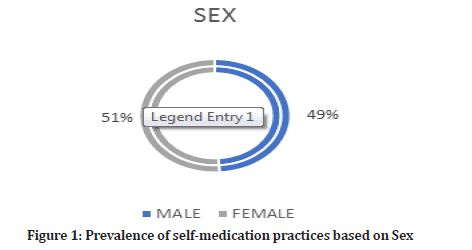
Figure 1: Prevalence of self-medication practices based on Sex.
As the Table 2 clearly depicts that around 86% of the respondents belong to student population. This is a very serious situation as this population is at risk of getting addicted to pain medication, develop drug dependency.
| Occupation | Frequency (n) | Percentage |
|---|---|---|
| Student | 86 | 56.2 |
| Doctor | 2 | 1.3 |
| Business | 13 | 8.5 |
| Engineer | 29 | 19 |
| Others | 23 | 15 |
| Total | 153 | 100 |
Table 2: Prevalence of self-medication practices based on occupation.
Monthly income of the family was obtained from the study participants and the per capita income of the participants was calculated, after taking into account the total members in the family. Modified BG Prasad’s classification was used to find out the socioeconomic class of the participants. Majority of the study participants belongs to upper class (69%). Among the study participants 38% of them preferred old prescription as the mode of self-medication followed by pharmacist advice (18%) (Table 3 and Figure 2). Table 4 shows that around 50% of the respondent’s preferred self-medication practices to save time. The Figure 3 depicts that around 71% of the participants preferred Allopathic form of self-medication, 15% preferred Ayurvedic medicines, and 9% preferred Homeopathy. Further results are expressed in Figures and Tables (Figures 4 to 6 and Tables 5 to 10).
| if no how did you prefer to treat the illness | Frequency (n) | Percentage |
|---|---|---|
| Old prescription | 38 | 44.7 |
| Pharmacist advice | 18 | 21.2 |
| Internet | 9 | 10.6 |
| Others | 20 | 23.5 |
| Total | 85 | 100 |
Table 3: Source of knowledge and Practice about of Self-medication.
| Why did you prefer self-medication? | Frequency (n) | Percentage |
|---|---|---|
| Clinic away | 39 | 25.5 |
| Save time | 38 | 24.8 |
| Old prescription | 6 | 3.9 |
| Cost effective | 13 | 8.5 |
| Others | 13 | 8.5 |
| Total | 109 | 71.2 |
Table 4: 50% of the respondents preferred self-medication practices to save time.
| Have you ever taken multi vitamins and supplements? | Frequency(n) | Percentage |
|---|---|---|
| Yes | 96 | 62.7 |
| No | 57 | 37.3 |
| Total | 153 | 100 |
Table 5: Intake of multivitamins and supplements.
| Have you ever self-medicated with antibiotics? | Frequency (n) | Percentage |
|---|---|---|
| Yes | 70 | 45.8 |
| No | 83 | 54.2 |
| Total | 153 | 100 |
Table 6: Prevalence of antibiotics usage by self-medication.
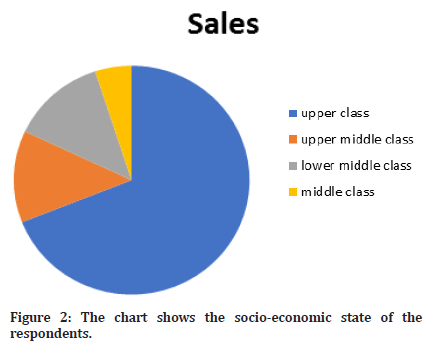
Figure 2: The chart shows the socio-economic state of the respondents.
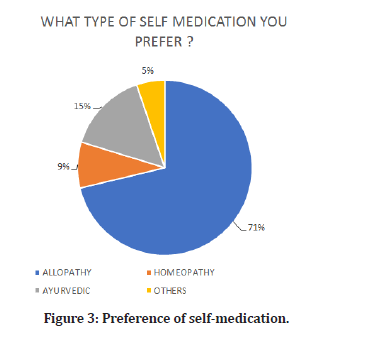
Figure 3: Preference of self-medication.
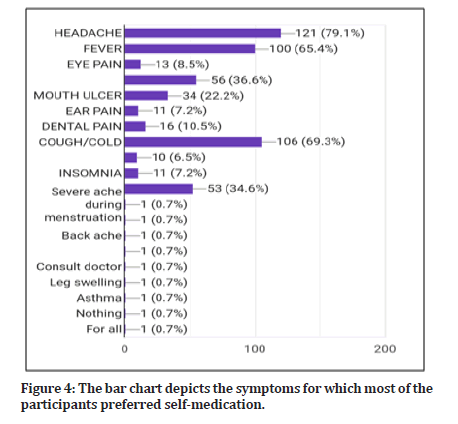
Figure 4: The bar chart depicts the symptoms for which most of the participants preferred self-medication.
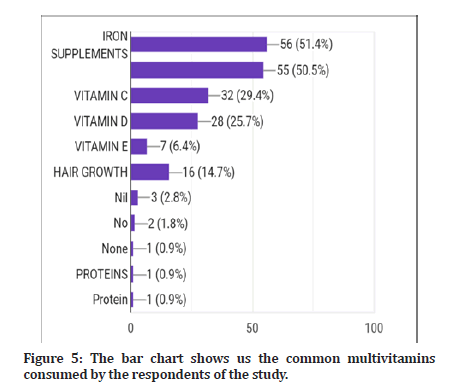
Figure 5: The bar chart shows us the common multivitamins consumed by the respondents of the study.
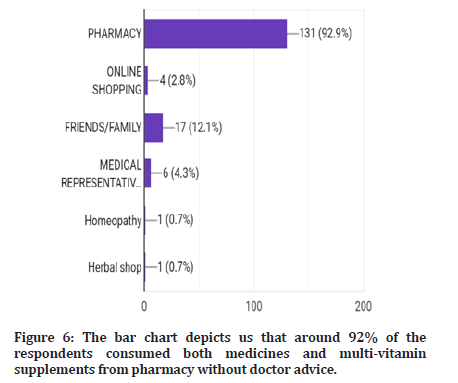
Figure 6: The bar chart depicts us that around 92% of the respondents consumed both medicines and multi-vitamin supplements from pharmacy without doctor advice.
| How did you know the dosage of antibiotics? | Frequency(n) | Percentage |
|---|---|---|
| Checking prescribing instructions | 24 | 15.7 |
| Internet | 16 | 10.5 |
| Pharmacist | 4 | 2.6 |
| Previous experience | 34 | 22.2 |
| None | 30 | 19.6 |
| Total | 108 | 70.6 |
Table 7: Knowledge about the dose of antibiotics.
| Why did you change the dosage? | Frequency(n) | Percentage |
|---|---|---|
| Former dose was ineffective | 18 | 11.8 |
| Former dose got over | 11 | 7.2 |
| Pharmacy ran out of former drug | 2 | 1.3 |
| Reduce side effects | 27 | 17.6 |
| Total | 58 | 37.9 |
Table 8: Change of dosage of drugs.
| When did you stop the course? | Frequency (n) | Percentage |
|---|---|---|
| After symptoms dissappeared | 44 | 28.8 |
| After complete course | 56 | 36.6 |
| Total | 100 | 65.4 |
Table 9: Stoppage of the course of self-medication.
| Do you know that you have to complete a full course of antibiotics? | Frequency(n) | Percentage |
|---|---|---|
| Yes | 119 | 77.8 |
| No | 34 | 22.2 |
| Total | 153 | 100 |
Table 10: Knowledge about the completion of full course of antibiotics.
Discussion
In our survey, 65.3% respondents used medication without doctor's advice which is similar to a study done by Rangari, et al. at Andhra Pradesh (68.1%) [3] and 44.7% used previous prescription to treat their illness over past 3 months. Over 56.9% of the respondents of our study preferred self-medication so as to save time from travelling to the clinic and also save money.70% of the respondents used paracetamol which is similar to a study conducted by Manish Jain et al. in an urban area of southern Rajasthan (73%) [4]. 90% of the respondents of our study obtained drugs from pharmacy with majority of them in student group aged 18-25 years which is very much higher than any studies. This is a rising concern as the not all pharmacies employ actual pharmacist and the amateurs and clerks working there hand over medicines we ask for. With such a high student consuming population certain regulations should be made to avoid this student population from getting drug dependent, drug tolerant, drug abuse and many other risk factors. Another interesting fact from our study is that around 9% of our respondents have experienced adverse effects from self-medication and then chose to consult a doctor. Apart from self-medicating for recurrent infections and allergies there is a huge population that self-medicates multi vitamins too. 62.5% of our respondents selfmedicate multi vitamins out of which at least 25% of them have accepted to start by seeing advertisements and from medical representatives advice. Increasing trend towards the use of homeopathic and ayurvedic drugs for chronic illnesses like bronchial asthma, joint pains, obesity, acid peptic disease, impotence and female infertility by our respondents. Majority of our respondents believed homeopathic drugs were safe and devoid of adverse effects. In our study the participants preferred self-medication for pain followed by respiratory diseases and allergy. Analgesics were the most common class of the drug which participants used for self-medication followed by antibiotics and anti-allergic. Among the analgesics the most common drug used was paracetamol which is similar to the study conducted in South India [5].
Previous researches have indicated that self-medication with drugs can predicate higher risk of new-onset drug and alcohol abuse among those with baseline mood disorders [6] and that people that self-medicate can get addicted due to self-medication [7]. Previous studies among students showed that self-medication with stimulants, sedatives and sleeping medications was connected with self-perceived academic load and stress [8]. The fact that respondents in our study had most frequently bought their medication in pharmacies, as had the students in most previous studies [9,10] suggests that legal obligations might not be obeyed and issuing of these drugs is not controlled. Surveys conducted in other countries also showed that most frequently students choose what medicine they would self-medicate based on their own knowledge and experience which is similar to our study. In our study, participants prefer to selfmedicate because the symptoms of their disease were not serious. This was also confirmed in other studies. However, long waits at the doctor's office was also a reasons why most of them preferred self-medication.
A greater proportion of urban respondents and respondents aged below the age of 40 years took selfmedication during the preceeding six-month period. The better socioeconomic status of the respondents, their better earning power, and the higher educational level are probably among the reasons. However, this is difficult to reconcile with the fact that economic reasons were commonly cited for self-medication. Because of better educational qualifications the prevalence of self-medication among the younger generation was higher. Similar study done in Nigeria [11] showed that decreasing pattern of self-medication with increase in age. It is known by the fact that as a person gets older, he or she starts visiting doctor more frequently [12].
Conclusion
Self-medication when practiced rationally could be beneficial to patients and healthcare delivery systems. In our study conducted among the urban population of the prevalence of self-medication practice was 63.5%, the major factor contributing to it being time management. The most commonly used drugs were analgesics for chronic pain, in comparison with other studies wherein antibiotics predominated in them. This caused a shift in focus from antibiotic stewardship to steps in reducing analgesic overuse. In this study it is highlighted that self-medication practice is widely prevalent among graduates. Health education among the public and government regulation are the cornerstone in limiting self-medication practice.
Disclaimers
There are no financial or non-financial disclaimers to disclose. The authors have no conflict of interest, and the work was not supported or funded by any drug company. This paper was not presented as an abstract or as a full article at any national or international conferences.
Funding Source
None
Conflict of Interest
None declared
References
- Kumar V, Mangal A, Yadav G, et al. Prevalence and pattern of self-medication practices in an urban area of Delhi, India. Med J DY Patil Univ 2015; 8:16.
- Selvaraj K, Kumar SG, Ramalingam A. Prevalence of self-medication practices and its associated factors in Urban Puducherry, India. Perspect Clin Res 2014; 5:32.
- Rangari GM, Bhaisare RG, Korukonda V, et al. Prevalence of self-medication in rural area of Andhra Pradesh. Fam Med Prim Care Rev 2020; 9:2891.
- Jain M, Prakash R, Bapna D, et al. Prevalence and pattern of self-medication practices in urban area of southern Rajasthan. Natl J Community Med 2015; 6:474-477.
- Katkuri S, Chauhan P, Shridevi K, et al. Prevalence of self-medication practices among urban slum dwellers in Hyderabad, India. Int J Community Med Public Health. 2016; 3:1816-1819.
- Lazareck S, Robinson JA, Crum RM, et al. A longitudinal investigation of the role of self-medication in the development of comorbid mood and drug use disorders: findings from the National Epidemiologic Survey on Alcohol and Related Conditions (NESARC). J Clin Psychiatry 2012; 73:10579.
- Ullah HA, Khan SA, Ali S, et al. Evaluation of self-medication amongst university students in Abbottabad, Pakistan; prevalence, attitude and causes. Acta Pol Pharm 2013; 70:919-922.
- Paula Martins A, da Costa Miranda A, Mendes Z, et al. Self‐medication in a Portuguese urban population: A prevalence study. Pharmacoepidemiol Drug Saf 2002; 11:409-414.
- Zafar SN, Syed R, Waqar S, et al. Self-medication amongst university students of Karachi: prevalence, knowledge and attitudes. J Pak Med Assoc 2008; 58:214.
- El Ezz NF, Ez-Elarab HS. Knowledge, attitude and practice of medical students towards self-medication at Ain Shams University, Egypt. J Prev Med Hyg 2011; 52:196-200.
- Osemene KP, Lamikanra A. A study of the prevalence of self-medication practice among university students in Southwestern Nigeria. Trop J Pharm Res 2012; 11:683-689.
- Abay SM, Amelo W. Assessment of self-medication practices among medical, pharmacy, health science students in Gondar University, Ethiopia. J Young Pharm 2010; 2:306-310.
Indexed at, Google Scholar, Cross Ref
Indexed at, Google Scholar, Cross Ref
Indexed at , Google Scholar, Cross Ref
Indexed at, Google Scholar, Cross Ref
Indexed at, Google Scholar, Cross Ref
Author Info
Kamini B1*, Vidhyashree MD2, Indra Bala Sundarrajan1, Arun Jayakumar U1 and Nandini MS3
1Department of Community Medicine, Sri Muthukumaran Medial College and Hospital, Chennai, India2Department of Community Medicine, Government Omandurar Medical College and Hospital, Chennai, India
3Department of Community Medicine, Sree Balaji Medical College and Hospital, Bharath Institute of Higher Education & Research, Chennai, India
Citation: Kamini B, Vidhyashree MD, Indra Bala Sundarrajan, Arun Jayakumar U, Nandini MS, Prevalence of Self Medication and Associated Factors among Urban Population of Thiruvallur District in South India, J Res Med Dent Sci, 2022, 10 (12): 86-90.
Received: 25-Nov-2022, Manuscript No. jrmds-22-81824; , Pre QC No. jrmds-22-81824(PQ); Editor assigned: 28-Nov-2022, Pre QC No. jrmds-22-81824(PQ); Reviewed: 13-Dec-2022, QC No. jrmds-22-81824(Q); Revised: 16-Dec-2022, Manuscript No. jrmds-22-81824(R); Published: 23-Dec-2022
